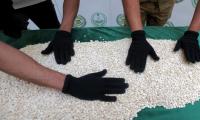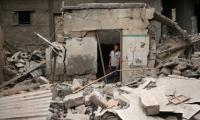LAHORE: Textile, the most pampered sector of our economy, failed to pay back on the concessions it availed in the last 50 years. Bangladesh, Vietnam, and Cambodia were nonentities in textile trade 30 years back, but have surged far ahead of Pakistan.
Textile sector is always on the forefront with demands for concessions when the new budget is in the making. They usually get what they demand.
Share of textiles in total global trade is less than seven percent, and Pakistan’s share in total textile trade is a little over one percent. Bangladesh and Vietnam enjoy more than double share in textile trade than Pakistan.
We are not talking about China and India, which are the two largest cotton producing countries in the world. Pakistan despite declining cotton production is still the fourth largest producer of this fibre. Bangladesh, Vietnam, and Cambodia do not produce cotton at all. One wonders what went wrong in Pakistan that has relegated us to a low position in textiles.
Did we over pamper the sector? Does our approach on facilitating each subsector of textile equally depicts the general approach of our planners to pass on concessions and subsidies uniformly to the entire population instead of prudent interventions where needed?
The textile tycoons (most of them spinners and weavers) are demanding the government to continue with the power subsidy it has been providing to the textile exporters for the last three years. This is even though the cost of power and energy has almost doubled globally.
They ask for concessional markup on long-term investment and highly concessional financing on exports. Energy and power account for around 30 percent of the cost of production in basic textiles and seven percent in readymade garments and knitwear.
There are other factors that impact cost of production equally, which the textile players do not take into account because the cost has gone down appreciably than competing economies. In dollar terms, it now comes to $125, it is $114 in Bangladesh, and $175 each in India and Vietnam.
Land cost/leasing price in $/sq meter is $60-100 in India, $80 in Bangladesh, $90 in Vietnam and $15-30 in Pakistan. Raw water cost (US cents per m3) is over 25 cents in India, 35 cents in Vietnam and Bangladesh, while it is only 15 cents in Pakistan. Steam cost in Pakistan is at least 20 percent less than in all these competing economies.
Any capable economic manager could see that the cost advantages that the textile sector enjoys in most spheres other than energy and power are much higher and provide the textile exporters with a slight advantage even if the power and energy subsidy is withdrawn.
This however would put the textile industries in Punjab at disadvantage on energy, as gas rates in other three provinces are much lower. There must however be a rationale as far as power and mark-up subsidies are concerned.
Spinners and the weavers consume 80 percent of the subsidy. Most of them operate on highly inefficient machines. This means that the government is subsidising their inefficiency. Yarn and fabric are the basic raw materials of the textile industry. Due to their inefficient operations, the benefits of government subsidies are not passed on to the value-added apparel exporters.
It would be prudent to allow free import of yarn and fabric to these exporters. The power and energy subsidy for apparel exporters must be increased and that of basic textiles reduced in such a manner that each sector avails 50 percent of the sanctioned subsidy.
We must take lessons from our less privileged competing economies that have side-lined us through prudent policies. Covid-19 proved a blessing for the textile sector. The government of Pakistan allowed this sector to operate with SOPS during Covid-19 peak. It was an opportunity for our apparel sector as all competing economies were under lockdown.
Pakistan had lost buyers after 9/11 that never returned due to the terrorist tag associated with our country. They were forced to return and were surprised to find that the quality of our readymade garments and knitwear was better than our competitors (Pakistani cotton is of short staple but is the best dye-able fibre in the world).
The apparel sector was caught off guard; it was not expecting such a high flow of orders. It had to refuse some, but it went for rapid expansion. The sector acquired all the closed machines and went for import of machines.
It is still operating in top gear. Its only problem is the availability of yarn at competitive rates. The apparel sector disposed of the spinners and weavers from among the top exporters of Pakistan.
Before Covid-19, Nishat Mills, Younus Textiles and Gul Ahmad made the top five list. In 2021, the top three exports were Style Textiles, Interloop Limited and Artistic Milliners (private Limited). All three are from high value-added knitwear and readymade garments sectors.
The surge in apparel exports can be seen from the fact that in 2018-19 the total textile exports stood at $13.39 billion of which knitwear exports accounted for $2.89 billion, bed wear $2.62 billion and readymade garments fetched $2.65 billion.
The total textile exports in the year 2019-20 went down to $12.52 billion, of which knitwear exports were $2.79 billion, bed wear $2.15 billion, readymade garments $2.55 billion.
In 2020-21, textile exports surged to $15.40 billion. Knitwear exports crossed the $3 billion barrier for the first time to reach $3.81 billion, bed wear exports touched $2.77 billion and that of readymade garments $3.03 billion.
In the first ten months of 2021-22, textile exports are at record high of $15.98 billion. Knitwear remains the leader, fetching $4.21 billion, bed wear exports have reached $2.72 billion and the readymade garments exports are $3.21 billion. Now the value-added sector dominates textile exports.
The image shows the head office of the Mari Petroleum Company Limited. — MPCL/FileKARACHI: Mari Petroleum Company...
The picture shows a logo of Federation of Pakistan Chambers of Commerce & Industry . — APP/FileLAHORE: Muhammad...
This representational image shows gold bars. — Unsplash/FileKARACHI: Gold prices in the local market dropped by...
An image of a site of MOL Pakistan Oil and Gas Company — MOL Pakistan's website/FileKARACHI The Oil and Gas...
A representational image showing calculation of tax on a calculator. — AFP/FileLAHORE: It took three years for the...
This image shows the President of Habib Metropolitan Bank, Sirajuddin Aziz , along with President Asif Ali Zardari....







